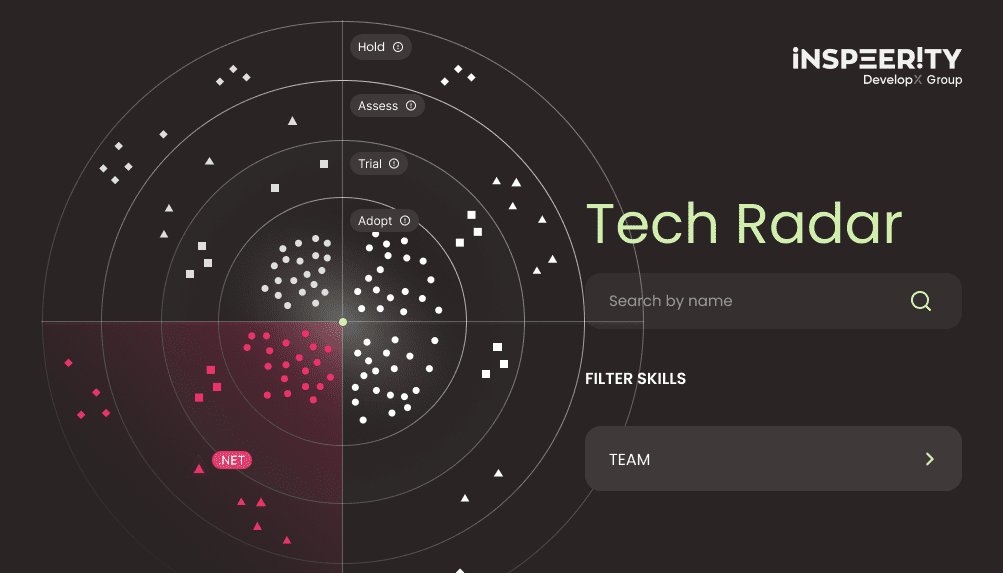There’s no “one shoe fits all” approach, and why should there be? Clients approach us from around the World. Each with their own expectations about how the collaboration should look like. That’s why we take the time to understand who we are working with first. It is common for clients to approach us with specific requirements in mind as they seek to form a partnership with a software company or outsourcing provider.
Let me show our top-list of criteria we have seen from talks with potential customers:
- Beating competitors’ rates.
- Beating competitors’ proposed ramp time.
- Providing relevant references in a particular field that prospects can talk to.
- Demonstrating the availability of a particular tech stack.
By engaging with our prospective clients over such points we hope to open the doors for the next steps. But what are these next steps?
Today’s blog details what you can expect while going through the process of establishing partnership with Inspeerity. We hope to make it clear that no matter your approach to business, we can help you achieve that perfect software solution.
Table of contents:
- Stage 1: It is all about sharing
- Stage 2: The importance of a Discovery Meeting
- Stage 3: Taking the time to decide on the correct solution
- Stage 4: Finalizing
- Summary
Stage 1: The beginning of partnership is all about sharing
Once receiving our client’s top questions, our main goal is to share as much relevant information as possible to catch your attention. To save time, I’ve already covered some of the most popular questions here (FAQ: Top 8 questions asked by our clients). It answers queries about the types of outsourcing we provide as well as detailing the resources we offer. Based on the request, we usually share:
- Our models of cooperation and rates applied to them accordingly. If you are curious about how we estimate a project’s costs, follow the link.
- Our average start times with information regarding the resources we have.
- Available references from current/former customers who can share with the client insights on cooperation with us.
- Provide case studies with required technologies including specifications like project duration, team compositions, the scope of work, solutions provided and our results.
Stage 2: The importance of a Discovery Meeting
Once the client has these details, and we demonstrate that we meet expectations, we move forward to the first meeting. The discovery meeting is an extremely important talk. Where we meet with C-Level Managers in charge of software development. The main goal of such meetings is to learn as much as possible about the project, the customer’s needs, the time frame for implementation and expected results. These calls involve CTOs and VPs from the client’s side, while Inspeerity’s COO Karol Wiszowaty or Tech Leaders such as Sebastian Dąbkowski and Piotr Filipowicz represent our Delivery Department. The goal of this meeting – is to understand the scope of the project and offer solutions. Here we are moving forward to finding the right solution.
Stage 3: Taking the time to decide on the correct solution
When it comes to solutions, it means deciding on the cooperation model that best fits the client. As we most often see, our customers need:
Team augmentation services
Custom software development and dedicated teams are projects where we deliver the whole team and are fully in charge of the delivery process. We organize the work, gather requirements, make decisions, and take full responsibility. In these projects we deliver such roles as Architects/Seniors/PMs/Scrum Masters/Engineers/QAs. As a rule, in such projects, we cooperate with the product owner, COO or investors on the client’s side.
While team augmentation services are applied for the projects when the management team is based on the client’s side. Depending on what is needed, the processes for different types of involvement will be different.
A. Custom software development/dedicated teams
Once we know the client’s idea, we are eager to propose the most relevant solution. When we talk about building a completed team to deliver the best software solution, we follow the next steps.
In cases where there is documentation in place, we’ll be glad to have a closer look at it, to evaluate the delivery time and the team needed. We might offer to start cooperation with an exploration phase, creating Low Level Documentation to be used as a base for further development. And nail down the final estimates for the implementation phase.
In other cases, it’s reasonable to start the project with Tech Leads that will prepare the foundations for further development, prepare and split the tasks that the expanding team could efficiently take on. For such projects our Sales Team, together with the Delivery Department, make a Commercial Proposal for the client with a detailed implementation plan, providing a predicted timeline and the project’s lifecycle.
B. Team augmentation
For projects where the client is looking to add additional developers to an existing team, we collect as much information as possible. We need to understand what kind of developer will be a good fit on both a technical and personal level. Then we check the availability of our developers for the quickest start time. Of course, it may happen, that we do not have any available developers on the bench. That’s when our HR department jumps in, helping us by providing selected candidates from the existing pipeline.
There is a strong tendency for clients to prefer to interview the candidates personally. So, we organize interview calls between the client and developers, where a Tech Lead or Account Manager is also present to understand the customers’ needs more. That allows us to bring more relevant candidates to the client in the future.
It might be that the client’s side want to discover the best way to start their project. In cases such as this, we can arrange for a special trial tech interview with one of our leading experts. The main focus of the interview is to analyze what you need for your project so we can get the best fit. It is sometimes the case that a client asks for one type of engineer when a project needs another. A trial tech interview is a way to eliminate this problem, helping you get your project off to a smooth start with the right team.
Stage 4: Finalizing the process
Once the client has chosen the optimal cooperation model, we move to the next step – negotiating and signing the Agreement and fulfilling the Statement of Work. This is the final stage where we finalize contracts and agree on the details (the cooperation start date, final team composition etc.).
And finally, the Big Day, the start of the cooperation. The process may take from several weeks to several months. As a real-life example: The client contacted us on February 13th, the contract was signed on April 12th and the first developer started on April 25th. Once the Contract and SoW are signed – we are officially partners! And this is where a new chapter starts.
The process summarized
It is clear that not all clients are the same. That’s why establishing partnership with Inspeerity involves from us taking the time to fully understand the customer’s needs and the current market situation. We have a well-structured process that enables us to provide custom software solutions for our clients. Our process begins with a discovery meeting and progresses through a detailed evaluation of the customer’s needs and expectations, negotiations, and signing the agreement. By engaging in this process, we ensure that our clients get the right software solution that meets their needs and requirements.
If you want to talk more, please feel free to contact me.




